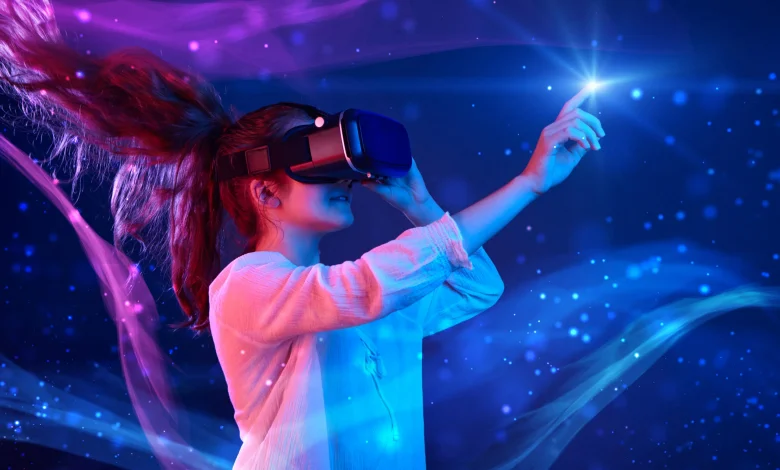
Introduction:
When we think of virtual reality (VR), we often envision immersive experiences that transport us to fantastical worlds where we can interact with environments and characters as if they were real. However, there exists another facet of VR that offers a different approach: non-immersive virtual reality. In non-immersive VR, users engage with virtual environments through screens or displays without fully immersing themselves in the virtual world. This lesser-known aspect of VR opens the door to a wide range of gaming experiences that blend the virtual and the real in unique and compelling ways. Let’s delve into the realm of non-immersive virtual reality in gaming and explore its potential to revolutionize the way we play and experience games.
The Concept of Non-Immersive Virtual Reality:
Non-immersive virtual reality differs from its immersive counterpart in its approach to user interaction and engagement. While immersive VR seeks to fully immerse users in virtual environments through headsets and motion tracking technologies, non-immersive VR allows users to interact with virtual environments through screens, monitors, or other display devices. This approach offers a more accessible and less intense VR experience, making it suitable for a wider audience, including those who may be prone to motion sickness or discomfort in immersive VR environments.
Exploring Non-Immersive Virtual Reality in Gaming: A Gateway to New Dimensions
Virtual Reality (VR) has long been synonymous with immersive experiences that transport users to captivating digital realms. However, there exists another facet of VR that offers a different approach: Non-Immersive Virtual Reality. Unlike immersive VR, where users are fully immersed in virtual environments through headsets and motion tracking, non-immersive VR allows users to engage with virtual content through screens or displays without complete immersion. This lesser-known aspect of VR presents a unique avenue for gaming experiences, blending the virtual and real worlds in innovative ways. Let’s delve into the concept of non-immersive virtual reality in gaming and explore its potential to redefine player experiences.
Understanding Non-Immersive Virtual Reality:
Non-immersive VR diverges from immersive VR in its approach to user interaction and engagement. While immersive VR aims to completely immerse users in virtual environments, often through head-mounted displays and spatial tracking, non-immersive VR enables interaction with virtual content through traditional screens, monitors, or other display devices. This approach offers a more accessible and less intense VR experience, making it suitable for a broader audience, including those who may experience discomfort or motion sickness in immersive VR environments.
A Blend of Real and Virtual Worlds:
The strength of non-immersive VR lies in its ability to blend the virtual and real worlds seamlessly. By integrating virtual elements into the user’s physical environment, non-immersive VR creates a mixed reality experience that enhances immersion and engagement. Whether it’s overlaying virtual objects onto the user’s surroundings using augmented reality (AR) technology or incorporating virtual characters and environments into live-action footage through mixed reality (MR) techniques, non-immersive VR blurs the boundaries between the virtual and real, offering a compelling fusion of digital and physical experiences.
Expanding Gaming Horizons:
In gaming, non-immersive VR introduces a realm of new possibilities and experiences. From augmented reality games that superimpose virtual elements onto the real world to mixed reality games that integrate virtual content with live-action environments, non-immersive VR offers gamers diverse experiences that transcend traditional gaming boundaries. Whether it’s battling virtual foes in your living room, solving puzzles amidst your surroundings, or exploring virtual worlds seamlessly integrated with reality, non-immersive VR provides gamers with immersive, interactive experiences that blend the virtual and real in innovative ways.
Accessibility and Inclusivity:
Non-immersive VR also addresses issues of accessibility and inclusivity. Unlike immersive VR, which often requires specialized hardware and can be cost-prohibitive, non-immersive VR experiences can be accessed using common devices such as smartphones, tablets, or computers. This accessibility broadens the audience for VR experiences, allowing more users to engage with virtual content without the need for expensive equipment or technical expertise. Additionally, non-immersive VR experiences are generally less likely to induce discomfort or motion sickness, making them suitable for users who may be sensitive to immersive VR environments.
Challenges and Future Developments:
Despite its promise, non-immersive VR poses its own set of challenges and considerations. Integration of virtual elements into the user’s physical environment seamlessly requires advanced AR and MR technologies capable of accurately tracking user movements and surroundings in real-time. Moreover, designing compelling experiences that leverage the unique capabilities of non-immersive VR while addressing the limitations of screen-based interactions remains a challenge for developers.
Conclusion: A New Dimension in Gaming:
In conclusion, non-immersive virtual reality represents a captivating frontier in gaming, offering experiences that blend the virtual and real in innovative and engaging ways. From augmenting reality with virtual elements to seamlessly integrating virtual content into live-action environments, non-immersive VR experiences open doors to new dimensions of adventure, exploration, and interaction. As technology continues to advance, the potential of non-immersive VR to redefine gaming experiences and bridge the gap between the virtual and real worlds is immense, promising a future where players can explore boundless realms of imagination and creativity.
Blending Virtual and Real Worlds:
One of the key strengths of non-immersive VR lies in its ability to blend the virtual and real worlds seamlessly. By integrating virtual elements into the user’s physical environment, non-immersive VR creates a mixed reality experience that enhances immersion and engagement. Whether it’s overlaying virtual objects onto the user’s surroundings through augmented reality (AR) technology or incorporating virtual characters and environments into live-action footage through mixed reality (MR) techniques, non-immersive VR blurs the lines between the virtual and the real, offering a compelling fusion of digital and physical experiences.
Blending Virtual and Real Worlds: The Evolution of Virtual Reality
Virtual Reality (VR) has long been envisioned as a means to transport users to entirely new worlds, disconnected from the physical realm. However, recent advancements have paved the way for a more nuanced approach, one that seeks to blend virtual and real worlds seamlessly. This fusion of realities holds immense promise, not only in gaming but also in various other fields such as education, training, and entertainment. Let’s explore the concept of blending virtual and real worlds in virtual reality and the transformative impact it promises to have on our experiences.
The Convergence of Virtual and Real:
Blending virtual and real worlds in VR involves integrating digital content into the physical environment or overlaying virtual elements onto real-world spaces. This convergence can be achieved through technologies such as Augmented Reality (AR) and Mixed Reality (MR). While AR superimposes virtual objects onto the real world, MR goes a step further by integrating virtual and real elements seamlessly, allowing for interactions between the two.
Enhancing Immersion and Engagement:
By blending virtual and real worlds, VR experiences become more immersive and engaging. Users no longer feel detached from reality but rather experience a seamless fusion of digital and physical elements. Whether it’s exploring virtual landscapes overlaid onto real-world environments or interacting with virtual characters in familiar surroundings, the integration of virtual and real worlds adds depth and realism to VR experiences, captivating users in ways previously unimaginable.
Applications Across Industries:
The blending of virtual and real worlds has far-reaching implications across various industries. In gaming, it offers players the opportunity to interact with virtual content in their physical surroundings, creating immersive and dynamic gameplay experiences. In education, AR and MR technologies can enrich learning by overlaying educational content onto real-world objects, making abstract concepts tangible and engaging. In healthcare, VR simulations can provide medical professionals with hands-on training in realistic environments, improving skills and patient outcomes.
Challenges and Considerations:
Despite its potential, blending virtual and real worlds in VR presents challenges and considerations. Technical limitations, such as tracking accuracy and latency, can impact the seamless integration of virtual and real elements. Designing intuitive user interfaces and interactions that bridge the gap between the digital and physical also requires careful consideration. Moreover, privacy and ethical concerns surrounding the use of AR and MR technologies in public spaces must be addressed to ensure widespread acceptance and adoption.
The Future of Virtual Reality:
As technology continues to advance, the future of virtual reality lies in the convergence of virtual and real worlds. From immersive gaming experiences that blur the line between fantasy and reality to educational simulations that bring learning to life, the possibilities are endless. By harnessing the power of AR and MR technologies, virtual reality has the potential to transform the way we interact with digital content, bridging the gap between the virtual and real worlds in ways that redefine our understanding of reality itself.
Conclusion:
In conclusion, blending virtual and real worlds in virtual reality represents a paradigm shift in how we perceive and interact with digital content. By seamlessly integrating virtual elements into the physical environment, VR experiences become more immersive, engaging, and relevant to our everyday lives. As technology continues to evolve, the boundaries between the virtual and real worlds will continue to blur, ushering in a new era of exploration, creativity, and innovation in virtual reality.
Expanding Gaming Possibilities:
In the realm of gaming, non-immersive VR opens the door to a wide range of new possibilities and experiences. From augmented reality games that superimpose virtual objects onto the real world to mixed reality games that integrate virtual characters and environments into live-action footage, non-immersive VR offers gamers a diverse array of experiences that transcend traditional gaming paradigms. Whether it’s exploring virtual worlds in the comfort of your own home, battling virtual creatures in your backyard, or solving puzzles in a virtual escape room, non-immersive VR provides gamers with immersive, interactive experiences that blend the virtual and real in exciting and innovative ways.
Expanding Gaming Possibilities: Blending Realities in Virtual Reality
Virtual Reality (VR) has emerged as a transformative technology that promises to revolutionize the gaming industry. By immersing players in virtual worlds, VR has the potential to deliver unparalleled gaming experiences that transcend traditional boundaries. However, the true power of VR lies not only in its ability to create immersive environments but also in its capacity to blend realities, seamlessly integrating virtual elements into the real world. This fusion of virtual and real worlds opens up a myriad of possibilities for gaming, transforming how we play, interact, and experience games. Let’s delve into the concept of blending realities in virtual reality and explore the expanding gaming possibilities it brings.
Blurring the Lines Between Virtual and Real:
Blending realities in VR involves integrating virtual elements into the physical environment or overlaying virtual content onto real-world spaces. This convergence can be achieved through technologies such as Augmented Reality (AR) and Mixed Reality (MR). AR superimposes virtual objects onto the real world, allowing players to interact with digital content in their physical surroundings. MR takes this a step further by seamlessly integrating virtual and real elements, creating immersive experiences where digital and physical worlds coexist and interact.
Enhancing Immersion and Engagement:
By blending realities, VR experiences become more immersive and engaging. Players no longer feel detached from reality but instead experience a seamless fusion of digital and physical elements. Whether it’s exploring virtual landscapes overlaid onto real-world environments or battling virtual enemies in familiar surroundings, the integration of virtual and real worlds adds depth and realism to gaming experiences, captivating players in ways previously unimaginable.
Creating Dynamic Gameplay Experiences:
The blending of realities in VR opens up a wealth of possibilities for dynamic gameplay experiences. Players can embark on virtual adventures that unfold within their own homes, with virtual elements seamlessly integrated into their surroundings. Whether it’s solving puzzles, navigating obstacle courses, or engaging in multiplayer battles, the ability to blend virtual and real worlds adds a new dimension to gaming, offering endless opportunities for creativity and innovation.
Expanding Genres and Narratives:
The integration of virtual and real worlds in VR allows for the exploration of new genres and narratives. Players can immerse themselves in interactive stories that unfold in their own environments, with virtual characters and events seamlessly integrated into their surroundings. From mystery-solving adventures set in real-world locations to science fiction epics that unfold within players’ homes, the blending of realities opens up a wealth of possibilities for storytelling and narrative exploration in gaming.
Challenges and Considerations:
While the blending of realities in VR offers exciting possibilities for gaming, it also presents challenges and considerations. Technical limitations, such as tracking accuracy and latency, can impact the seamless integration of virtual and real elements. Designing intuitive user interfaces and interactions that bridge the gap between the digital and physical also requires careful consideration. Moreover, privacy and ethical concerns surrounding the use of AR and MR technologies in gaming must be addressed to ensure widespread acceptance and adoption.
The Future of Gaming:
As technology continues to advance, the future of gaming lies in the blending of realities in virtual reality. From immersive adventures that unfold within players’ own environments to interactive narratives that seamlessly integrate virtual and real elements, the possibilities are endless. By harnessing the power of AR and MR technologies, virtual reality has the potential to transform gaming into a truly immersive and interactive experience that blurs the lines between fantasy and reality.
Conclusion:
In conclusion, blending realities in virtual reality represents a paradigm shift in gaming, offering players immersive experiences that transcend traditional boundaries. By seamlessly integrating virtual elements into the real world, VR opens up a wealth of possibilities for dynamic gameplay experiences, expanded genres, and interactive narratives. As technology continues to evolve, the blending of realities in VR promises to redefine how we play, interact, and experience games, ushering in a new era of gaming that blurs the lines between virtual and real worlds.
Accessibility and Inclusivity:
Another advantage of non-immersive VR is its accessibility and inclusivity. Unlike immersive VR, which requires expensive headsets and specialized hardware, non-immersive VR can be experienced using devices that are readily available to most consumers, such as smartphones, tablets, and computers. This accessibility makes non-immersive VR more inclusive, allowing a wider range of users to enjoy virtual reality experiences without the need for expensive equipment or technical expertise. Additionally, non-immersive VR is less likely to cause discomfort or motion sickness in users, making it suitable for individuals who may be sensitive to the immersive nature of traditional VR environments.
Breaking Barriers: Accessibility and Inclusivity in Virtual Reality
Virtual Reality (VR) has the potential to transport us to fantastical realms, providing immersive experiences that captivate our senses and spark our imaginations. However, for many individuals, accessing and enjoying VR content has been hindered by barriers related to physical abilities, technological limitations, and socioeconomic factors. Recognizing the importance of accessibility and inclusivity, developers and innovators are working tirelessly to break down these barriers and make VR experiences more accessible to all. Let’s explore the crucial role of accessibility and inclusivity in virtual reality and the strides being made to ensure that everyone can participate in this transformative technology.
Understanding Accessibility in VR:
Accessibility in VR refers to the design and implementation of VR experiences that accommodate individuals with diverse physical, cognitive, and sensory abilities. This includes considerations such as user interface design, control options, visual and auditory cues, and the provision of alternative modes of interaction for users with disabilities. By making VR content more accessible, developers can ensure that individuals with disabilities can fully engage with and enjoy virtual experiences without encountering barriers or limitations.
Breaking Down Physical Barriers:
One of the primary barriers to accessibility in VR is physical limitations that may prevent individuals with disabilities from using traditional VR hardware, such as headsets and motion controllers. To address this challenge, developers are exploring alternative input methods, such as voice commands, gesture recognition, and eye-tracking technology, which allow users to interact with virtual environments without the need for complex physical movements. Additionally, advancements in haptic feedback technology are making it possible for individuals with sensory impairments to experience tactile sensations within virtual environments, enhancing their immersion and engagement.
Ensuring Cognitive Accessibility:
Cognitive accessibility is another critical aspect of ensuring inclusivity in VR. This involves designing user interfaces and interactions that are intuitive, easy to understand, and customizable to accommodate individuals with cognitive impairments or learning disabilities. By providing clear instructions, visual cues, and options for customization, developers can ensure that users of all cognitive abilities can navigate and interact with VR content effectively.
Addressing Socioeconomic Barriers:
In addition to physical and cognitive barriers, socioeconomic factors can also impact access to VR technology and content. High costs associated with VR hardware and software, as well as the need for high-speed internet connections and powerful computing devices, can create barriers for individuals from lower-income households or underserved communities. To address these challenges, developers are exploring alternative distribution models, such as cloud-based VR platforms and subscription services, which reduce the financial barriers to accessing VR content.
Promoting Diversity and Representation:
Inclusivity in VR also encompasses representation and diversity, ensuring that VR experiences reflect the rich tapestry of human experiences and perspectives. This includes creating content that represents individuals from diverse backgrounds, cultures, and identities, as well as providing options for customization and personalization to accommodate users’ unique preferences and identities. By promoting diversity and representation in VR, developers can create experiences that resonate with a wide range of users and foster a sense of belonging and inclusion within virtual environments.
Collaborative Efforts and Future Directions:
Achieving accessibility and inclusivity in VR requires collaborative efforts from developers, designers, researchers, advocacy groups, and users themselves. By working together to identify barriers, develop innovative solutions, and advocate for inclusive design practices, we can ensure that VR technology and content are accessible and welcoming to all individuals, regardless of their abilities or backgrounds. As VR technology continues to evolve, the importance of accessibility and inclusivity will only grow, paving the way for a future where everyone can participate in and benefit from the transformative power of virtual reality.
Conclusion: A More Inclusive Virtual Future:
In conclusion, accessibility and inclusivity are essential pillars of a truly inclusive virtual reality ecosystem. By breaking down physical, cognitive, and socioeconomic barriers, and promoting diversity and representation, we can create VR experiences that are accessible, engaging, and empowering for users of all abilities and backgrounds. As we continue to push the boundaries of VR technology and design, let us strive to build a future where everyone can participate in and contribute to the immersive worlds of virtual reality, enriching our lives and broadening our horizons in the process.
Challenges and Future Directions:
While non-immersive VR offers exciting possibilities for gaming and interactive entertainment, it also presents its own set of challenges and considerations. One challenge is the integration of virtual elements into the user’s physical environment in a seamless and natural way. Achieving this level of integration requires sophisticated AR and MR technologies that can accurately track the user’s movements and surroundings in real-time. Additionally, there is the challenge of designing compelling and engaging experiences that leverage the unique capabilities of non-immersive VR while also addressing the limitations and constraints of screen-based interactions.
Conclusion: The Evolution of Virtual Reality Gaming:
In conclusion, non-immersive virtual reality represents an exciting evolution in the world of gaming, offering a diverse array of experiences that blend the virtual and real in innovative and compelling ways. Whether it’s exploring virtual worlds in augmented reality, battling virtual creatures in mixed reality, or solving puzzles in a virtual escape room, non-immersive VR provides gamers with immersive, interactive experiences that transcend traditional gaming paradigms. As technology continues to evolve and mature, the potential of non-immersive VR to revolutionize the way we play and experience games is vast and promising, offering a gateway to new worlds of adventure, exploration, and imagination.











